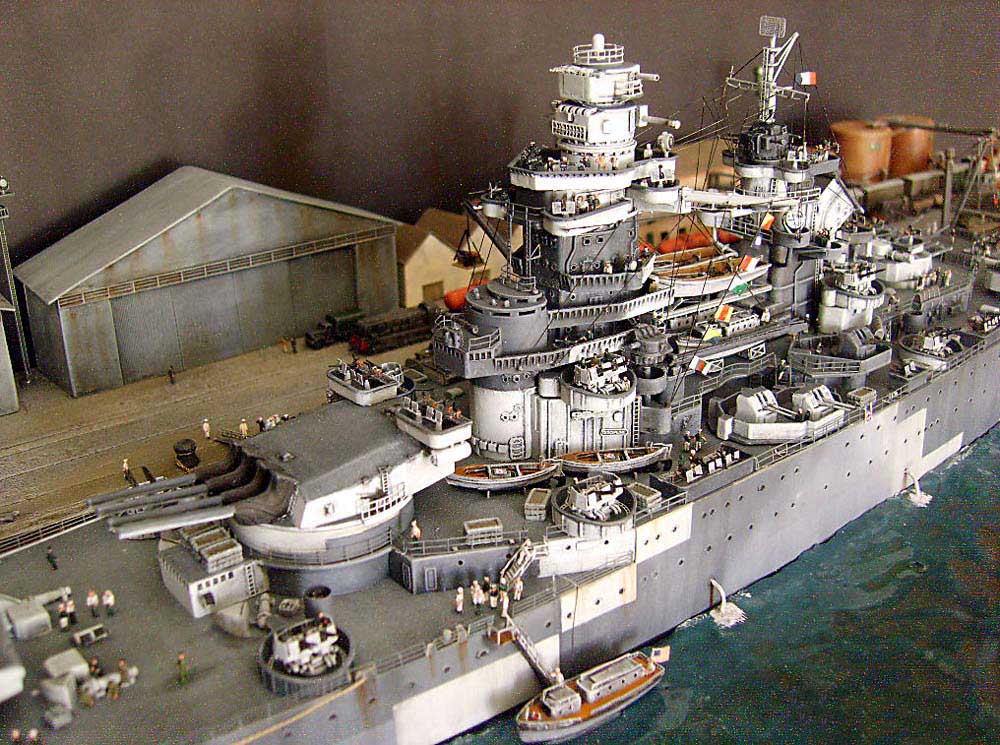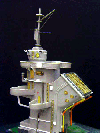by Louis Carabott

1/350 Richelieu, New York 1943 (Trumpeter)

French Battleship Le Richelieu, September 1943.
I wanted to portray the ship in a diorama in a New York Navy Yard before leaving for Europe to join the Home Fleet at Scapa Flow after an extensive refit and trials in the East Coast. The battleship was painted in a soft edge MS-3X camouflage utilizing USN colors.
The ship came from Trumpeter. The hull was sawn off to make the kit a waterline model. Several corrections had to be made in the superstructure especially the top bridge, the radar and range finder equipment and additional extensive detail added to achieve the required result of the battleship. Motor boats were scratchbuilt, bofors guns were correctly altered, anchor chains were added and all piping and trunking on the superstructure was scratchbuilt from telephone wire. All the detail in the lower superstructure was scratchbuilt from bits and pieces of evergreen plastic rods. L’Arsenal upgrading set was used and this was as well further detailed to enhance the model. The rigging was not an easy task and very fine straightened fuse wire was used. Additional boats were added on the forward deck. Figures came from a mixture of L’Arsenal and Fujimi offerings.
The model was airbrushed in White Ensign Colourcoats enamels which I always use, and I will recommend them to any marine modeler. Of course a lot of masking had to be done to get the many camouflage patterns throughout the whole ship. Shadows and highlights were laid on using acrylics and the intermediate colour was blended in using a combination of drybrushing and sponging the paint, always in a downward motion. The model was finally weathered in oils and I tried to be as subtle as possible to achieve the correct medium, the half way road, not too heavy, not too insignificant. It is pertinent to note that although the ship had still just been painted it still had to be weathered as it spent a full month in the Atlantic Ocean for extensive trials. A final coat of matt varnish was sprayed on the ship.
The Brooklyn class tugs came from Commander Models, one was left as a steam powered tug, the other was converted to represent a fuel powered vessel. They were also detailed. They were still in use in US harbors in the late 1940’s.
I wanted the diorama to look really busy representing the departure of the Richelieu for a long stretch of sailing to Scapa flow which obviously involves a lot of preparation, so there’s a lot of action going on; cargo being loaded, personnel and top brass seeing the ship off, etc, etc.
All the detail on the wharf was scratchbuilt.
The wharf was made out of balsa wood, covered with a fine layer of clay using a rolling pin to flatten it. The railway and crane rail lines were then engraved. The jibs, the harbor lights, the crane and other embellishments were all scratcbuilt from photoetch leftovers, plasticard and rods. Airgun pellets were used for bollards. The front overlooking the sea was covered in engraved plastic card to represent a wooden support structure. Rubber washers were used to cushion the ship’s hull against the wharf.
The port cargo ship, barges and boats in the seascape were all scratchbuilt.
The buildings were scratchbuilt using a combination of plastic card, tinlets of paint, soldering wire and bits and pieces from the photoecth spares box. I had to be very careful to keep the scale accurate.
The train engines, as well as the rolling stock, were all scratchbuilt. The trucks and other vehicles all came from conversions from one type of L'Arsenal 1/350 US truck. Again a mixture of Fujimi and L’Arsenal Figures were used.
I must thank Messrs Sebastien Lausdat and Claudio Matteini who provided me with all the correct and accurate material required to make this project as faithful as possible to this beautiful ship and without whose help I wouldn’t have completed this project.
 |
 |
 |
 |
 |
 |
 |
 |
 |
 |
